Spring 2015 A publication of the Wildlife Division—Getting Texans Involved
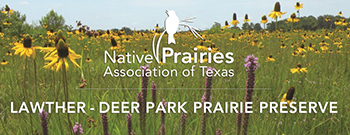 Saving the Lawther-Deer Park Prairie Preserve: "Rarest of the Rare"
Saving the Lawther-Deer Park Prairie Preserve: "Rarest of the Rare"
Photos © Don Verser
By Lan Shen
The Lawther-Deer Park Prairie Preserve is an unbelievable piece of living history, a rare remnant of our natural heritage - the coastal prairie - that once covered nine million acres in Texas and Louisiana. For thousands of years before the first European settlers arrived, the coastal prairie was described as "a sea of grass" as tall as a man and teeming with wildflowers, grassland birds and wildlife from the bison to the horned lizard. Today, more than 99% of that ecosystem has disappeared, lost to cropland and development, decimated by overgrazing, or degraded due to fire suppression and disappearance of the bison. Of the large ecosystems of North America, the coastal prairie has been called "the rarest of the rare." It is so rare that most Texans, even local residents, do not recognize one - have never seen one. Hopefully, with the preservation of Deer Park Prairie, this will change.
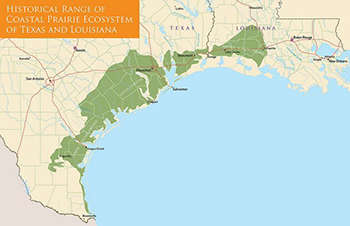
Finding Prairie Remnants
In recent years, a group made up mainly of native plant enthusiasts has been seeking these rare prairie remnants to collect seeds and rescue prairie plants in order to propagate them for prairie restorations. Most of the prairie hunters find these remnants by learning to recognize indicator plants while driving 35 to 65 mph. Spotting the tall bloom stalk of the ovateleaf prairie plantain (Amoglossum ovatum) or the white blooming rattlesnake master (Eryngium yuccifolium) while driving the back roads in July leads to screeching brakes and a U-turn to check the field for other indicator plants such as the dominant native grasses of the coastal prairie: little bluestem (Schizachyrium scoparium), brownseed paspalum (Paspalum plicatulum) or Indian grass (Sorghastrum nutans). In late summer, that brake-screeching plant may be lavenderpink blazing stars (Liatris sp.) or mists of pink Gulf muhly (Muhlenbergia capillaris). In fall, seeing stands of dominant native tallgrasses is a sure sign of a good prairie remnant.
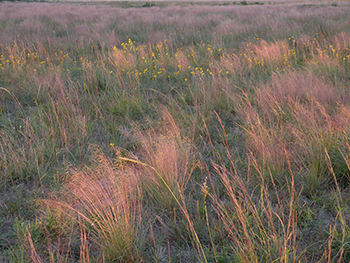
The Deer Park Prairie however, was not visible from the roads. In August 2011, Don Verser, a local birder and naturalist volunteer, was using GoogleEarth to map known prairie remnants when he became intrigued by a large field behind a cemetery in an area of Houston containing other prairie remnants. He had heard of preserved prairie remnants adjacent to cemeteries, so he decided that this field, surrounded on three sides by residential houses and less than five miles from chemical refineries, was worth a visit.
On the first visit, Don and his fellow prairie hunters found that the field had just been mowed. Even though none of the plants were blooming, they recognized a large number of blue sage (Salvia azurea), indicative of an extremely high quality prairie remnant. Other indicators seen that day were the blooming blazing star (Liatris pycnostachya), rosinwood (Silphium radula) and Texas coneflower (Rudbeckia texana). More plants were found in unmowed patches and around the tree motts.
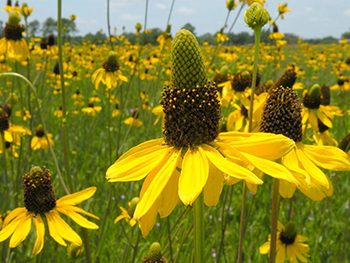
Subsequent visits to the extremely biodiverse Deer Park Prairie led to a growing list of no-longer-common prairie plants and grassland birds. Texas Parks and Wildlife Department botanist Jason Singhurst documented over 300 species of native plants. Efforts to save the prairie began soon after this discovery. Fortunately, the landowner was willing to sell and allowed access to the land for fundraising and field trips.
Managing and Preserving the Prairie
Toward the end of the fundraising campaign, upon the request of Jennifer Lorenz, the board of the Native Prairies Association of Texas (NPAT) agreed to take on the responsibilities and cost of owning and managing the Deer Park Prairie, while the Bayou Land Conservancy will protect the land by holding the conservation easement. NPAT is a non-profit land trust protecting about 2,100 acres of prairie throughout Texas. NPAT and its Executive director, Pat Merkord, have vast experience managing prairies. With this partnership, Deer Park Prairie was saved from development.
In early 2014, once the land was protected, work to manage and preserve this gem of a prairie began for NPAT. By that time, Deer Park Prairie had not been hayed or mowed for almost three years. Prairies are a disturbance ecosystem. In pre-settlement times, bison grazed and trampled an area then moved on, fires started by nature or by native Americans moved through and other disturbances combined to disturb the area. These renewed the prairie. They suppressed the growth of trees and woody shrubs such as eastern baccharis (Baccharis halmifolia) and wax myrtle (Myrica cerifera), and removed dead plant material from the previous growing seasons. (Most prairie plants are perennials whose tops die in winter and growth starts anew from the plant base in the spring.) Today, the best remnants are hay fields that are cut annually or biannually to remove the hay.
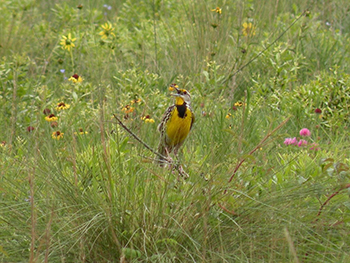
After three years without haying, the Deer Park Prairie was overgrown with Chinese Tallow (Triadica sebifera) and baccharis and full of dead plant litter. The prairie was mowed, which must be done in the summer when the field is dry. During the winter months, large parts of this prairie remain ankle deep in water, allowing such wetland plants as powdery thalia (Thalia dealbata) to survive. Many of the Chinese tallow had grown to diameters larger than the brush hog could handle and had to be cut by volunteers with hand saws and chain saws. After cutting, these plants readily resprout. To kill the plant, it must be treated with herbicide on the fresh cut or on the new sprouts. Once the trees and shrubs are under control, and the dead plant litter is cut and decomposing, haying can resume on fresh green growth thus maintaining the disturbance.
Exotic and invasive trees are only part of the problem though. Preserving the prairie also involves removing other invasive species such as Vasey grass (Paspalum urvillei), torpedograss (Panicum repens), St. Augustine grass (Stenotraphrum secondatum), Brazilian vervain (Cerbena braziliensis) and more. The extreme north section of the prairie, which had been disturbed in the past, now has much King Ranch bluestem (Bothriochloa ischaemum) a non-native, very invasive and very hard-to-eliminate grass. Control of these exotic plants will involve careful use of herbicide, hand removal, solarization and other techniques. Where necessary, seed collected from the prairie can be used to reseed areas where exotic plants have been removed.
The prairie is now protected for the animals and plants that call it home. During winter months until well into May, meadowlarks, a grassland bird on the Audubon Society's Common Birds in Decline list, sing and nest in the tall grass. Tours are offered to increase interest in prairies and seed collection trips are held to preserve and share the wonderful, diverse plant life of this unique place. This is a private property though, and as such visitors are welcomed by appointment only.
Lan Shen is one of the many dedicated volunteers at Deer Park Prairie.
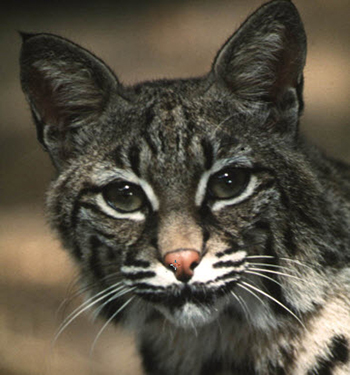 Dallas-Fort Worth Area Residents Participating in Study of Urban Bobcats
Dallas-Fort Worth Area Residents Participating in Study of Urban Bobcats
By Derek Broman
So, why the big increase in numbers? First, we at Texas Parks and Wildlife are very fortunate to receive positive responses from the public when we request their involvement. This bobcat study is no exception. Second, a lot of effort has gone into recruiting outdoor enthusiast such as Master Naturalists and nature photographers to contribute to the DFW Carnivores project. Once those individuals have been exposed to iNaturalist, the overwhelming benefits of that website retain these users and naturally keep them coming back to contribute to the project as well as numerous others! One of the most popular features of iNaturalist includes assistance with organism ID from experts and peers, a feature that has made contributors more inclined to share observations of tracks, scat, or other sign that can be difficult to identify. The increased willingness to report animal sign has greatly impacted this project as animal sign is often the only information available for stealthy, secretive carnivores that yield few sightings. Even when someone views a carnivore, often times it dashes off well before a photo can be taken but tracks or scat make for easy photo opportunities. On numerous occasions, DFW Carnivores project contributors have commented that they never gave much thought to recording scat or tracks. Once they discovered that was welcomed information, they quickly realized how frequent animal sign is in any landscape.
The DFW Carnivores project highlights the commonality of carnivores throughout the Metroplex. Because of that, it has served as a valuable resource for municipal staff and conservation organizations that encourage coexistence with our native wildlife. They use the project maps to educate the public and show that these critters are popping up everywhere, yet conflict is rarely observed nor are such events making front page news. Once the public understands that coexistence is possible, and has likely occurred for some time, the request for relocation or eradication is retracted.
Spring is the busy season for carnivore reports. The vegetation is low or dead, making it easier for us to view them and the soft ground promotes excellent track impressions. In an urban setting, culverts and bridges are excellent locations to look for sign. Also, during the spring months many of our carnivores will enter the breeding season, which increases their visibility when traversing areas in search of a mate. While a lot of reptiles, insects and flowers are absent in these colder months, mammals and their sign provide us with something to discover as we take advantage of the lengthening days. iNaturalist and the DFW Carnivores project serves as an outlet for urban wildlife enthusiasts during the dormant time of the year, so we encourage you to be on the lookout for our native carnivores and be sure to add your observations to iNaturalist.org.
Derek is an Urban Wildlife Biologist working in the Dallas Fort Worth area out of Cedar Hill State Park.
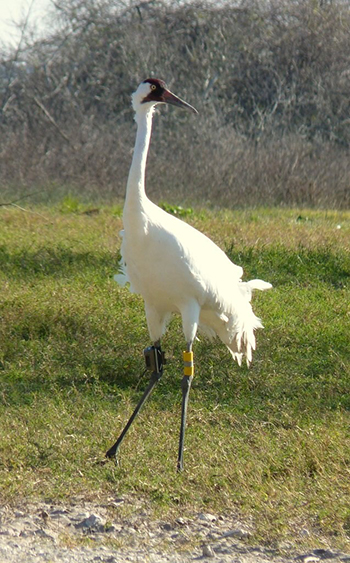 "You Gotta Dance With the One Who Brung Ya"
"You Gotta Dance With the One Who Brung Ya"
Photos © Sue Kersey
By Chester McConnell, Friends of the Wild Whooper
Known as the Aransas-Wood Buffalo (AWBNP) population because of the winter and summer habitats they use, this self-sustaining population nests and rear their chicks in Canada's Wood Buffalo National Park (WBNP). A few weeks after the chicks fledge, they migrate with their parents 2500 miles to ANWR on the Texas coast where they spend the winter months.
The most significant cause of decline in the Whooping Crane population came as a result of habitat loss. Millions of acres of wetlands were drained for agricultural interests destroying virtually all of their nesting habitats except those in WBNP.
Private conservation organizations and government officials finally recognized the plight of the Whooping Cranes in the 1940s and initiated efforts to protect and manage the birds. As a result, the population of the remaining wild flock increased over the following 60 years. Today there are approximately 300 birds in this population.
With this increase in numbers, the Whooping Cranes are running out of secure wintering habitats along the Texas coast and secure stop-over-points along the migration route. Presently, only about half of the occupied wintering habitat is within the safeguarded areas of the ANWR complex. Land development and increased land use intensity along the migration route is reducing even more wetland habitats.
Whooping Crane pairs and their current year chicks defend an area averaging 300 acres from other Whooping Cranes. This need for large acreages means suitable habitat for the cranes has been occupied on ANWR. Now, roughly half of the Aransas-Wood Buffalo flock use private lands or other locations as their winter habitat.
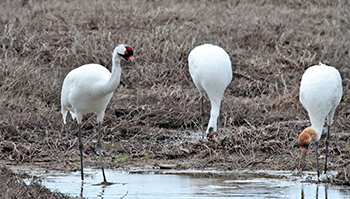
Felipe Chavez Ramirez PhD, Director of Conservation Programs at Gulf Coast Bird Observatory recently described the habitat problems at http://friendsofthewildwhoopers.org/private-lands-important-whooping-crane-wintering-along-texas-coast/. He explains that members of the Whooping Crane Recovery Team have identified winter habitat as the limiting factor to continued increase in this wild migratory population. He also revealed that a coalition of organizations have developed a conservation action plan that highlights necessary measures to ensure protection of all current and future potential Whooping Crane wintering habitats as a high priority.
Dr. Chavez elaborated that "Since more than half of the Whooping Crane population winters on private lands-and in the future the percentage is likely to increase-finding mechanisms to ensure the integrity of these lands as Whooping Crane habitat is a high priority. A recent evaluation conducted in conjunction with the International Crane Foundation and Harte Research Institute shows that potential high quality habitat along the coast in Aransas, San Antonio and Matagorda Bay systems will be a smaller proportion of potential territories within protected areas in the future. As little as 26% of all potential suitable winter habitat for Whooping Cranes will be within a protected area in the mentioned bay systems."
Given the growing shortage of suitable habitat for the AWBNP population, are there other opportunities to establish additional Whooping Crane populations? Since the 1970s those interested in Whooping Cranes have sought additional remedies to reduce some of the threats. Several different research projects have sought to establish new populations of Whooping Cranes in different locations of the U.S. including two failed reintroduction attempts in Rocky Mountain-Grays Lake project and the Central Florida project. A third attempt to establish an alternate population, the eastern Migratory population was initiated in 2000 and is too new to draw conclusions. As of June 2014 there were 95 birds in this population.
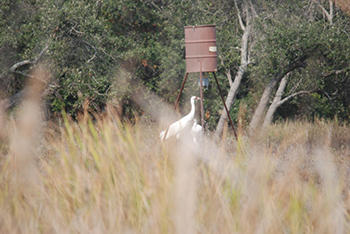
A fourth effort intends to establish another non-migratory population of Whooping Cranes in Louisiana's White Lake area. It is believed that these released Whooping Cranes would have a much better chance in the 1.3 million acres of marsh, open water and Chenier habitat in southwestern coastal Louisiana. The recovery plan goal is for Louisiana to reach a subpopulation of 25 to 30 productive pairs, which means about 130 cranes in Louisiana. This process could take 15 to 20 years. The Louisiana Department of Wildlife and Fisheries Whooping Crane reintroduction program has released cranes into the wild from White Lake Wetlands Conservation area each year since 2011. Sixty four Whooping Cranes have been released in Louisiana as of December 4, 2014, 40 of which have survived including the 14 recently released.
To date, none of the experimental projects to establish new Whooping Crane populations have registered substantial positive results. In the meantime the AWBNP flock continues to increase. This self-sustaining population provides the best opportunity to increase Whooping Crane numbers while reducing threats to the population. The major problem is that the birds need many more acres of secure winter habitat.
The current downlisting goal for the Whooping Crane Recovery Plan is that, if no self sustaining populations can be reintroduced, then at least 250 breeding pairs or 1000 individuals should be in the AWBNP flock. This means that we need to ensure that at least there is sufficient area with useable habitat for at least 1000 birds along the Gulf coast. The call for renewed focus on AWBNP wild population is in no way intended to denigrate other Whooping Crane projects. Importantly however, all other Whooping Crane experimental projects have originated from birds in the wild population. We need to support the ones "who brung us to the dance."
An old song lyrics says "You've got to dance with the ones who brung ya..." "Dance with the one that brung you" was a favorite expression of University of Texas football coach Darrell Royal. In sports, it means to go with the players and plays that result in wins. In reality, it's no different with Whooping Cranes.
Chester is president of Friends of the Wild Whoopers, a non profit organization to preserve and protect the AWBNP Whooping Cranes.
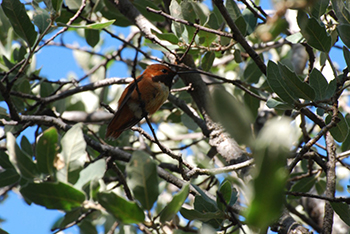 Citizen Science in the City
Citizen Science in the City
By Mark Klym
Texas Nature Trackers is a volunteer based umbrella of citizen science based projects working with scientists at Texas Parks and Wildlife Department to collect data on specific taxa of conservation concern within the state. These volunteers, often after training by our specialists, collect and share their data, which increases our knowledge about the species and often provides them with meaningful field work experience.
Have these projects had success? Yes. Volunteers with the Texas Mussel Watch program provided the first record of invasive zebra mussels while sampling along the Brazos River watershed a few years ago. Others have refound species that were thought to no longer occur in some waterways. Volunteers with Texas Whooper Watch provided information and tracking on Whooping Cranes from the Louisiana population that spent a summer in Texas just two years ago - often providing information on movements of the birds before tracking software in Louisiana could download data from the gps locators. These volunteers followed the birds across two different lakes in the heart of the DFW metroplex. Volunteers with the Texas Hummingbird Roundup have shown that major cities, like Houston, can have a very diverse hummingbird population. They have also shown that hummingbirds remain in Texas cities year round.
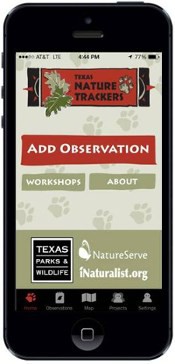
Today, most of the Texas Nature Trackers projects are conducted online - through the iNaturalist platform or by providing email based feedback forms to the team. You can participate in projects that monitor birds, mussels, plants, mammals, turtles and more. There is literally something for everyone's interest. Learn more by visiting the projects at tpwd.texas.gov/huntwild/wild/wildlife_diversity/texas_nature_trackers/. You may find something new and contribute to science!
Mark is an Information Specialist working out of Bastrop.
Back Porch
By Richard Heilbrun
The art work was skillfully crafted by the award winning artist Clemente Guzman. Nearly 17,000 people voted in an online poll and they overwhelmingly chose the Lucifer Hummingbird and the Western Diamondback rattlesnake. Many people told us that they would buy the license plate if they knew that the legislature would give Texas Parks & Wildlife the proceeds. Fortunately, the 2013 legislature changed the way license plate funds are received by the state treasury. Those changes mean that TPWD now receives 100% of the revenues generated by the plates. With the addition of two new plates, we will be able to fund many more conservation projects throughout the state. In the last three years alone, Conservation License Plates have provided more than $337,000 to nearly 30 projects across the state. They are some amazing projects too! Take a look at some of these worthy causes:
- Wildlife Conservation Camp
- Nature photography training to teachers in the Rio Grande Valley
- Native prairie restoration on the Gulf Coast
- Habitat restoration on public land in San Antonio
- Educational loaner trunks at the Chihuahuan Desert Research Institute.
- Land preservation at the world famous Bracken Bat Cave
- Endangered species research across the state
- Habitat modelling for the state endangered Texas Horned Lizard
- Improving access to nature for disadvantaged youth
Which wildlife species represents you? Are you the beautiful, fast moving hummingbird? Or is the bold rattlesnake more your style? Or perhaps you are more the classic Texas horned lizard. The plates cost just $30 and can be purchased any time. You do not have to wait until your registration is due to make the change. Order yours today at conservationplate.org or at your Tax Assessor's office. Show what drives you!
Richard is Conservation Outreach Program Leader at Texas Parks and Wildlife Department working out of San Antonio.


 Texas Parks and Wildlife Department, 4200 Smith School Road, Austin, TX 78744
Texas Parks and Wildlife Department, 4200 Smith School Road, Austin, TX 78744


